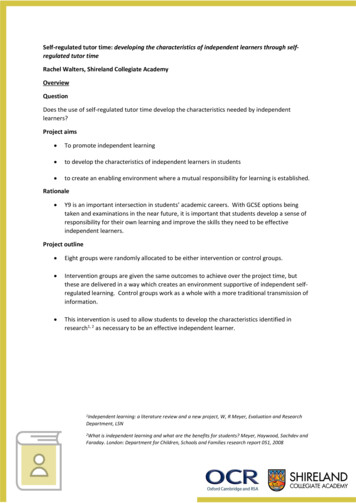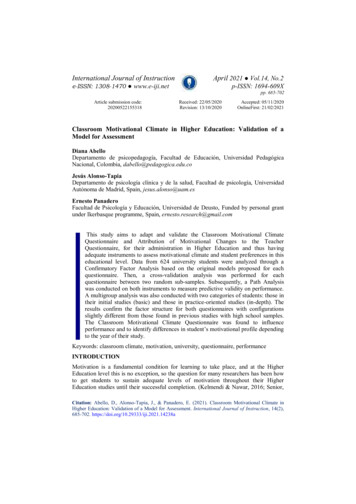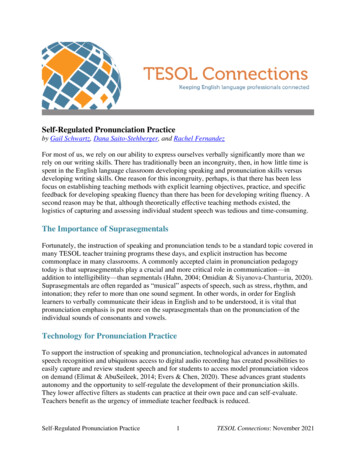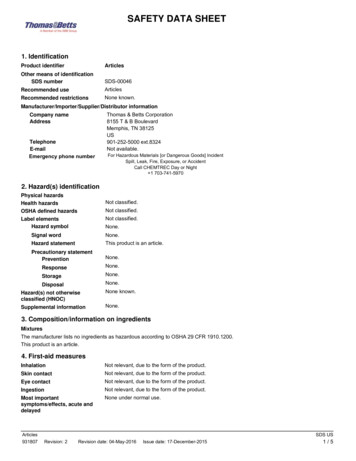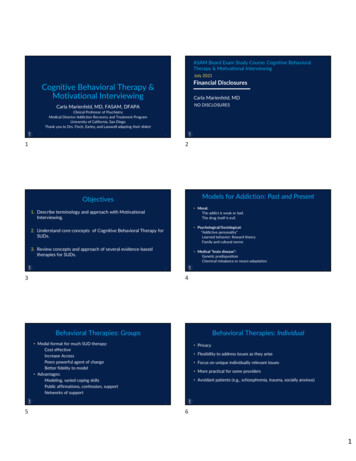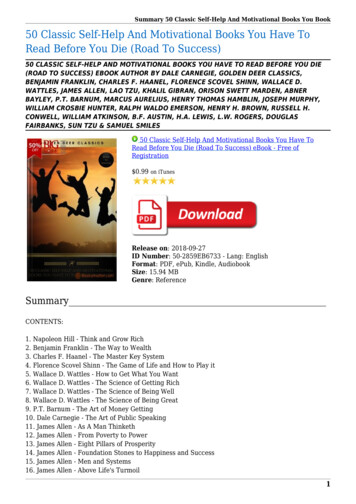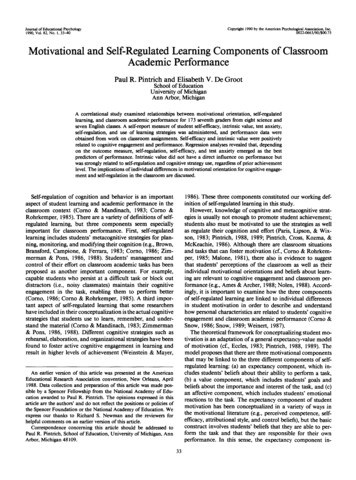
Transcription
Copyright 1990 by the American Psychological Association, Inc.O022-O663/90/ 00.75Journal of Educational Psychology1990, Vol. 82, No. 1,33-40Motivational and Self-Regulated Learning Components of ClassroomAcademic PerformancePaul R. Pintrich and Elisabeth V. De GrootSchool of EducationUniversity of MichiganAnn Arbor, MichiganA correlational study examined relationships between motivational orientation, self-regulatedlearning, and classroom academic performance for 173 seventh graders from eight science andseven English classes. A self-report measure of student self-efficacy, intrinsic value, test anxiety,self-regulation, and use of learning strategies was administered, and performance data wereobtained from work on classroom assignments. Self-efficacy and intrinsic value were positivelyrelated to cognitive engagement and performance. Regression analysesrevealedthat, dependingon the outcome measure, self-regulation, self-efficacy, and test anxiety emerged as the bestpredictors of performance. Intrinsic value did not have a direct influence on performance butwas strongly related to self-regulation and cognitive strategy use,regardlessof prior achievementlevel. The implications of individual differences in motivational orientation for cognitive engagement and self-regulation in the classroom are discussed.Self-regulation of cognition and behavior is an importantaspect of student learning and academic performance in theclassroom context (Corno & Mandinach, 1983; Corno &Rohrkemper, 1985). There are a variety of definitions of selfregulated learning, but three components seem especiallyimportant for classroom performance. First, self-regulatedlearning includes students' metacognitive strategies for planning, monitoring, and modifying their cognition (e.g., Brown,Bransford, Campione, & Ferrara, 1983; Corno, 1986; Zimmerman & Pons, 1986, 1988). Students' management andcontrol of their effort on classroom academic tasks has beenproposed as another important component. For example,capable students who persist at a difficult task or block outdistractors (i.e., noisy classmates) maintain their cognitiveengagement in the task, enabling them to perform better(Corno, 1986; Corno & Rohrkemper, 1985). A third important aspect of self-regulated learning that some researchershave included in their conceptualization is the actual cognitivestrategies that students use to learn, remember, and understand the material (Corno & Mandinach, 1983; Zimmerman& Pons, 1986, 1988). Different cognitive strategies such asrehearsal, elaboration, and organizational strategies have beenfound to foster active cognitive engagement in learning andresult in higher levels of achievement (Weinstein & Mayer,1986). These three components constituted our working definition of self-regulated learning in this study.However, knowledge of cognitive and metacognitive strategies is usually not enough to promote student achievement;students also must be motivated to use the strategies as wellas regulate their cognition and effort (Paris, Lipson, & Wixson, 1983; Pintrich, 1988, 1989; Pintrich, Cross, Kozma, &McKeachie, 1986). Although there are classroom situationsand tasks that can foster motivation (cf., Corno & Rohrkemper, 1985; Malone, 1981), there also is evidence to suggestthat students' perceptions of the classroom as well as theirindividual motivational orientations and beliefs about learning are relevant to cognitive engagement and classroom performance (e.g., Ames & Archer, 1988; Nolen, 1988). Accordingly, it is important to examine how the three componentsof self-regulated learning are linked to individual differencesin student motivation in order to describe and understandhow personal characteristics are related to students' cognitiveengagement and classroom academic performance (Corno &Snow, 1986; Snow, 1989; Weinert, 1987).The theoretical framework for conceptualizing student motivation is an adaptation of a general expectancy-value modelof motivation (cf., Eccles, 1983; Pintrich, 1988, 1989). Themodel proposes that there are three motivational componentsthat may be linked to the three different components of selfregulated learning: (a) an expectancy component, which includes students' beliefs about their ability to perform a task,(b) a value component, which includes students' goals andbeliefs about the importance and interest of the task, and (c)an affective component, which includes students' emotionalreactions to the task. The expectancy component of studentmotivation has been conceptualized in a variety of ways inthe motivational literature (e.g., perceived competence, selfefficacy, attributional style, and control beliefs), but the basicconstruct involves students' beliefs that they are able to perform the task and that they are responsible for their ownperformance. In this sense, the expectancy component in-An earlier version of this article was presented at the AmericanEducational Research Association convention, New Orleans, April1988. Data collection and preparation of this article was made possible by a Spencer Fellowship from the National Academy of Education awarded to Paul R. Pintrich. The opinions expressed in thisarticle are the authors' and do not reflect the positions or policies ofthe Spencer Foundation or the National Academy of Education. Weexpress our thanks to Richard S. Newman and the reviewers forhelpful comments on an earlier version of this article.Correspondence concerning this article should be addressed toPaul R. Pintrich, School of Education, University of Michigan, AnnArbor, Michigan 48109.33
34PAUL R. PINTRICH AND ELISABETH V. DE GROOTvolves students' answers to the question, "Can I do this task?"Different aspects of the expectancy component have beenlinked to students' metacognition, their use of cognitive strategies, and their effort management. In general, the researchsuggests that students who believe they are capable engage inmore metacognition, use more cognitive strategies, and aremore likely to persist at a task than students who do notbelieve they can perform the task (e.g., Fincham & Cain,1986; Paris & Oka, 1986; Schunk, 1985).The value component of student motivation involves students' goals for the task and their beliefs about the importanceand interest of the task. Although this component has beenconceptualized in a variety of ways (e.g., learning vs. performance goals, intrinsic vs. extrinsic orientation, task value, andintrinsic interest), this motivational component essentiallyconcerns students' reasons for doing a task. In other words,what are students' individual answers to the question, "Whyam I doing this task?" The research suggests that studentswith a motivational orientation involving goals of mastery,learning, and challenge, as well as beliefs that the task isinteresting and important, will engage in more metacognitiveactivity, more cognitive strategy use, and more effective effortmanagement (e.g., Ames & Archer, 1988; Dweck & Elliott,1983; Eccles, 1983; Meece, Blumenfeld, & Hoyle, 1988; Nolen, 1988; Paris & Oka, 1986).The third motivational component concerns students' affective or emotional reactions to the task. The important issuefor students involves the question, "How do I feel about thistask?" Again, there are a variety of affective reactions thatmight be relevant (e.g., anger, pride, guilt), but in a schoollearning context one of the most important seems to be testanxiety (Wigfield & Eccles, 1989). Test anxiety has beenshown to be related to perceptions of competence (e.g., Nicholls, 1976), but it can be theoretically and empiricallydistinct. Research on test anxiety has been linked to students'metacognition, cognitive strategy use, and effort management(e.g., Benjamin, McKeachie, Lin, & Holinger, 1981; Culler &Holahan, 1980; Tobias, 1985). Although the other two motivational components generally show simple, positive, andlinear relations with the components of self-regulated learning, the results for test anxiety are not as straightforward. Forexample, Benjamin et al. (1981) found that although highanxious students seemed to be as effortful and persistent aslow-anxious students, they appeared to be very ineffectiveand inefficient learners who often did not use appropriatecognitive strategies for achievement. On the other hand, otherresearch suggests that high-anxious children are not persistentor avoid difficult tasks (Hill & Wigfield, 1984). Accordingly,test anxiety may be related to the three components of selfregulated learning in different ways.Previous research suggests that the expectancy and valuecomponents will be positively related to the three self-regulated learning components, whereas the research on test anxiety does not suggest such simple relations. Accordingly, onepurpose of this study was to examine and clarify the empiricalrelations between the motivational and self-regulated learningcomponents. In addition, because very few prior studies haveincluded all three motivational components in their designs,a second purpose involved examining the potential interactiverelations of the three motivational components on self-regulated learning components. Finally, the relations betweenmotivation, self-regulated learning, and student performanceon classroom academic tasks were examined. The focus onclassroom assessments of student performance reflects a concern for ecologically valid indicators of the actual academicwork that students are asked to complete in junior highclassrooms (Doyle, 1983). Most students spend a great dealof classroom time on seatwork assignments, quizzes, teachermade tests, lab problems, essays, and reports rather than onstandardized achievement tests (Stiggins & Bridgeford, 1985).These assignments may not be the most psychometricallysound assessments of student academic performance, but theyare closely related to the realities of instruction and learningin most classrooms (Calfee, 1985). If we are to develop modelsof student motivation and self-regulated learning that arerelevant for much of the academic work in classrooms, thenit is important to examine student performance on these typesof academic tasks (cf., Doyle, 1983; Pintrich et al., 1986).Accordingly, the third purpose will provide empirical data onhow motivation and self-regulated learning components mayoperate independently or jointly to influence student academic performance in the classroom. In summary, the threeresearch questions were:1. How are the three motivational components related tothe components of self-regulated learning?2. What are the interactions among the three motivationalcomponents and their relation to the self-regulated learningcomponents?3. How are the motivational and self-regulated learningcomponents related to student performance on classroomacademic tasks?MethodSubjectsThe sample included 173 seventh-grade students from eight scienceand seven English classrooms from a predominantly White, middleclass, small city school district in southeastern Michigan. There were100 girls (57.8%) and 73 boys (42.2%). The mean age of the studentswas 12 years, 6 months in January at the end of the first semester.The school district did not track students for the science or Englishclasses at the two junior high schools involved in this study. Accordingly, the sample of students included a range of student achievementlevels.MeasuresThe students responded to a self-report questionnaire (the Motivated Strategies for Learning Questionnaire—MSLQ, see Appendix)that included 56 items on student motivation, cognitive strategy use,metacognitive strategy use, and management of effort. Students wereinstructed to respond to the items on a 7-point Likert scale (1 notat all true of me to 7 very true of me) in terms of their behavior inthe specific science or English class. Items were adapted from variousinstruments used to assess student motivation, cognitive strategy use,and metacognition (e.g., Eccles, 1983; Harter, 1981; Weinstein,Schulte, & Palmer, 1987). Factor analysis was used to guide scaleconstruction, resulting in exclusion of some of the items from thescales because of a lack of correlation or stable factor structure.
35SPECIAL SECTION: MOTIVATION AND SELF-REGULATED LEARNINGAnalysis of the motivational items revealed three distinct motivational factors: self-efficacy, intrinsic value, and test anxiety. The SelfEfficacy scale (a .89) consisted of nine items regarding perceivedcompetence and confidence in performance of class work (e.g., "Iexpect to do very well in this class," "I am sure that I can do anexcellent job on the problems and tasks assigned for this class," "Iknow that I will be able to learn the material for this class"; cf. Eccles,1983; Schunk, 1981). The Intrinsic Value scale (a .87) was constructed by taking the mean score of the student's response to nineitems concerning intrinsic interest in ("I think what we are learningin this Science class is interesting") and perceived importance ofcourse work ("It is important for me to learn what is being taught inthis English class"; cf., Eccles, 1983) as well as preference for challengeand mastery goals ("I prefer class work that is challenging so I canlearn new things"; cf., Harter, 1981). Four items (e.g., "I am sonervous during a test that I cannot remember facts I have learned,""When I take a test I think about how poorly I am doing"; cf., Liebert& Morris, 1967) concerning worry about and cognitive interferenceon tests were used in the Test Anxiety scale (a — .75).On the basis of the results of the factor analysis, two cognitivescales were constructed: cognitive strategy use and self-regulation.The Cognitive Strategy Use scale (a .83) consisted of 13 itemspertaining to the use of rehearsal strategies (e.g., "When I readmaterial for science class, I say the words over and over to myself tohelp me remember"), elaboration strategies such as summarizing andparaphrasing (e.g., "When I study for this English class, I put important ideas into my own words"), and organizational strategies (e.g.,"I outline the chapters in my book to help me study", cf., Weinsteinet al., 1987). Although metacognitive and effort management strategies were intended to be separate scales originally, factor analysis ofthe items did not support the construction of two different scales.One scale, labeled Self-Regulation (a .74), was constructed frommetacognitive and effort management items. The items on metacognitive strategies, such as planning, skimming, and comprehensionmonitoring (e.g., "I ask myself questions to make sure I know thematerial I have been studying," "I find that when the teacher is talkingI think of other things and don't really listen to what is being said,"and "I often find that I have been reading for class but don't knownwhat it is all about," with the latter two items reflected before scaleconstruction) were adapted from Weinstein et al. (1987) and Zimmerman and Pons (1986). Effort management strategies were adaptedfrom Zimmerman and Pons (1986) and included students' persistenceat difficult or boring tasks and working diligently (e.g., "Even whenstudy materials are dull and uninteresting, I keep working until Ifinish" and "When work is hard I either give up or study only theeasy parts," with the latter item reflected before scale construction).Academic performance was measured by collecting data on studentperformance on actual classroom tasks and assignments. Examinationof the classroom tasks and assignments for the different classroomsrevealed three general categories of tasks: (a) in-class seatwork andhomework, (b) quizzes and tests, and (c) essays and reports. In-classseatwork and homework usually involved answering worksheets orquestions based on textbook readings. Exams and quizzes requiredrecall orrecognitionof information from textbooks as in the seatworkassignments, although the students were not allowed to refer to theirtextbooks on the quizzes and exams. Essays and reports involved theproduction of original prose on topics assigned by the teacher orchosen by the student. The essays and reports often required studentsto use other sources (e.g., library books and encyclopedias) besidesthe textbook to complete the assignment. Students' performance onthese three types of generic assignments were averaged over the courseof the semester to generate one summary score for each of the threetasks.The grading system in effect for all classrooms assigned points(usually on a 100-point scale) or grades (on the traditional letter scale)for correct and accurate performance on classroom tasks. All theteachers involved used grading procedures that separated behavioralcompliance and effort from actual performance by providing separatemarks for attendance and class participation. These latter marks werenot included in the summary measures of classroom performance.The distribution of grades for all classrooms followed an individualistic, criterion-referenced system that allowed all students the possibility ofreceivingan A or a 100 on an assignment (i.e., none of theteachers used an explicit "grading curve" to assign grades). Semestergrades also were obtained. We collected the first semester overallgrade in the course, administered the MSLQ, and then collectedsecond semester grades. All five performance scores (seatwork, tests/quizzes, essays/reports, and the two semester grades) were standardized (converted to T scores) within each classroom before dataanalysis.ResultsThe first question of the study concerned the relationsbetween the motivational and self-regulated learning components; the results were generally as expected. Table 1 displaysthe zero-order correlations and summary statistics for themotivational and self-regulated learning variables. As predicted, higher levels of self-efficacy (r .33) and intrinsicvalue (r .63) were correlated with higher levels of cognitivestrategy use. Test anxiety was not associated with cognitivestrategy use. Paralleling these findings for cognitive strategyuse, higher levels of self-efficacy (r .44) and intrinsic value{r .73) were correlated with higher levels of self-regulation.Test anxiety was negatively correlated with self-regulation (r - . 13), albeit not at the .05 significance level. In addition,simple polynomial regressions with second- and third-orderterms (Neter, Wasserman, & Kutner, 1985) for test anxietyrevealed no curvilinear relations between test anxiety and thecognitive-strategy-use or self-regulation variables.The second research question concerned the potential interactions between the motivational variables on the twocognitive scales. The two cognitive scales were correlated witheach other and were used as dependent variables in a multivariate analysis of covariance with prior achievement (firstsemester grade) as a covariate (MANCOVA). In order to test forinteractions, the three motivational variables were dichotomized by median splits, forming three low/high categoricalvariables to be used as independent variables in the MANCOVA.Before the MANCOVA was run, gender differences were exam-Table 1Summary Statistics and Zero-Order Correlations forMotivation and Self-Regulated Learning Variables1.2.3.4.5.VariableIntrinsic valueSelf-efficacyTest anxietyStrategy useSelf-regulationMSDNote. N 173.*p .440.895.471.003.581.675.200.7755.030.83
36PAUL R. PINTRICH AND ELISABETH V. DE GROOTined in preliminary analyses. Boys and girls did not differ onany of the classroom performance variables or on the twocognitive variables and intrinsic value. There were, however,gender differences in self-efficacy; boys (M 5.78) ratedthemselves more efficacious than did girls ( M 5.23), r( 171) 3.53, p .0005, and boys (M 3.19) felt less test anxiousthan did girls (M 3.86), ?(171) 2.67, p .008. Preliminarymultivariate analyses of variance (MANOVAS) revealed no maineffects of gender on the two cognitive variables or interactiveeffects with the three motivational variables. Consequently,gender was excluded from the MANCOVA. TWO assumptionsfor the MANCOVA were checked before the analysis proceeded.The tests for homogeneity of regression coefficients of thecovariate for different levels of the motivational variableswere not significant, suggesting that a common regressioncoefficient was appropriate for the covariance portion of theanalysis (Neter, Wasserman, & Kutner, 1985). In addition,Box's M test for homogeneity of covariance matrices was notsignificant; this provided assurance that a crucial assumptionof MANOVA was met (Stevens, 1986).The results from the MANCOVA revealed a significant multivariate test for the covariate of prior achievement, Hotelling's statistic .05, S 1, M 0, N 80 1/2, F(2, 163) 3.97, p .02. The univariate tests showed that prior achievement was a significant predictor of self-regulation, r .17,F(l, 164) 4.80, p .03, MSe 0.38, but not cognitivestrategy use, r .04, F(l, 164) .27, p .61, MS, 0.43.Students who were achieving high grades were more likely toreport using self-regulatory strategies than were low-achievingstudents, although there were no differences in their cognitivestrategy use. There were two main effects of the motivationalvariables. The multivariate test for self-efficacy was significant, Hotelling's statistic .05, S 1, M 0, N 80 1/2,F(2, 163) 4.07, p .02. The univariate tests were bothsignificant also. Students high in self-efficacy were more likelyto report use of cognitive strategies, adjusted M 5.41, F(\,164) 4.24, p .04, MS, 0.43, and self-regulatory strategies, adjusted M 5.31, F(l, 164) 8.16, p .005, MSt 0.38, than students low in self-efficacy (cognitive strategyadjusted M 4.97; self-regulation adjusted M 4.74). Theother main effect involved intrinsic value with a significantmultivariate test, Hotelling's statistic .42, S 1, M 0, N 80 1/2, F(2, 163) 34.25, p .0001. The two univariatetests were also significant. Students high in intrinsic valuewere more likely to use cognitive strategies, adjusted M 5.58, F(l, 164) 45.93, p .0001, MS, 0.43, and to beself-regulating, adjusted M 5.49, F{\, 164) 68.40, p .0001, MS, 0.38, than students low in intrinsic value(cognitive strategy adjusted M 4.80, self-regulation adjustedM 4.56). The main effect for test anxiety was not significantat the multivariate or univariate level, nor were any of theinteraction terms for the motivational variables significant atthe multivariate or univariate level.The third research question concerned how the motivational and cognitive variables were related to student performance. Table 2 displays the zero-order correlations for themotivational, cognitive, and performance variables. As predicted, higher levels of intrinsic value and self-efficacy wereassociated with higher levels of student achievement acrossall types of tasks (see Table 2). Higher levels of test anxietywere only significantly related to lower levels of performanceon exams and quizzes (/ -.21) as well as grades at timesone (r -.24) and two (r -.23), but not for seatworkperformance or essays and lab reports. In addition, higherlevels of cognitive strategy use and self-regulation were associated with higher levels of achievement on all assignments,with the exception of seatwork performance and cognitivestrategy use (see Table 2). All the performance measures weresignificantly and positively correlated with each other, suggesting that performance levels were relatively stable overtime. Because first and second semester grades were highlycorrelated (/ .77), one measure, the average grade for thetwo semesters, was used in the analyses. A MANOVA with thefour performance measures as dependent variables, followingthe logic of the previous analysis for the two cognitive variables, was ruled out because the test (Box's M) for homogeneity of covariance matrices was significant. Accordingly, toexamine the independent relations between the motivationaland cognitive variables on student performance, four separateregression analyses were run with the three motivational andtwo cognitive variables as predictors of student performanceon seatwork, exams/quizzes, essays/reports, and averagegrade for the course.Regression analysis of seatwork performance (r2 .10)revealed that self-regulation was positively related to seatworkperformance (partial r . 18, p .02). In addition, somewhatsurprisingly, cognitive strategy use was negatively related toseatwork performance (partial r -.18, p .02). The threeTable 2Zero-Order Correlations Between Motivation and Self-Regulated Learning Variablesand PerformanceGradeVariableMotivation componentsIntrinsic valueSelf-efficacyTest anxietySelf-regulated learning componentsStrategy useSelf-regulationNote. /V 173.*p .Q5. * * p . 0 1 . ***/? .19*.36***2.20**.36***
SPECIAL SECTION: MOTIVATION AND SELF-REGULATED LEARNINGmotivational variables were not significantly related to seatwork performance when included in the regression analyseswith the two cognitive variables. For exams/quizzes (r2 .12), test anxiety was negatively related to performance (partial r —.19, p .02) and self-regulation was positivelyrelated (partial r .26, p .0005). Cognitive strategy use,self-efficacy, and intrinsic value were not significant predictorsof exam performance in comparison with test anxiety andself-regulation. The results for essays/reports (r2 .17) displayed a pattern similar to that revealed by the results forseatwork. None of the motivational variables was significant,but self-regulation (partial r .22, p .0004) was positivelyrelated to performance and cognitive strategy use negativelyrelated (partial r -.17, p .02). Regression analysis onaverage grade (r2 .22) revealed that the significant predictorswere self-efficacy (partial r . 18, p .02) and self-regulation(partial r .22, p .005). Analyses of variance (ANOVAS) withthe motivational and cognitive variables as independent dichotomous variables did not reveal any two- or three-wayinteractions on the four student performance outcomemeasures.The findings that cognitive strategy use, which had a significant positive zero-order correlation with most of the performance measures (see Table 2), had negative partial correlationsand betas with performance when self-regulation was includedin the regression equation suggested a suppressor effect wasoperating. Further examination of the partials, betas, andzero-order correlations between cognitive strategy use, selfregulation, and the performance measures following the procedures to detect suppressor variables (e.g., Conger, 1974;Tzelgov & Stern, 1978) suggested that cognitive strategy usecould be classified as a negative suppressor variable. Cognitivestrategy use and self-regulation were highly correlated witheach other (r .83) and self-regulation was a better predictorof performance. When the variance in performance due toself-regulation was accounted for, the remaining variancecorrelated with cognitive strategy use revealed a negativerelation. This suggested that some students who reported thatthey often used cognitive strategies also reported infrequentuse of self-regulatory strategies. Examination of the actualnumber of students who showed this pattern revealed that 14students (8% of the sample) could be classified as being in thetop third on cognitive strategy use and the bottom third inself-regulation. Simple two-way ANOVAS did not reveal a significant interaction between cognitive strategy use (three levels) and self-regulation (three levels), but the group low inself-regulation and high in cognitive strategy use consistentlyhad means on the performance measures well below the 50.0mean for the total sample (seatwork M 45.6, exam M 47.3, essay M 42.0, average grade M 43.2) or the othergroup means, which were all above 46.2.DiscussionThe results provide an empirical base for the specificationand elaboration of the theoretical linkages between individualdifferences in students' motivational orientation and theircognitive engagement and self-regulation in classroom settings37(cf., Corno & Mandinach, 1983; Snow, 1989; Weinert, 1987).The motivational components were linked in important waysto student cognitive engagement and academic performancein the classroom. Self-efficacy was positively related to studentcognitive engagement and performance. Students who believed they were capable were more likely to report use ofcognitive strategies, to be more self-regulating in terms ofreporting more use of metacognitive strategies, and to persistmore often at difficult or uninteresting academic tasks. Theserelations were independent of and did not interact with priorachievement levels or intrinsic value and test anxiety. Selfefficacy, however, was not significantly related to performanceon seatwork, exams, or essays when the cognitive engagementvariables were included in the regression analyses. Thesefindings suggest that self-efficacy plays a facilitative role inrelation to cognitive engagement as suggested by Schunk(1985), but that the cognitive engagement variables are moredirectly tied to actual performance. This implies that teachingstudents about different cognitive and self-regulatory strategies may be more important for improving actual performance on classroom academic tasks, but that improving students' self-efficacy beliefs may lead to more use of thesecognitive strategies (cf., Borkowski, Weyhing, & Carr, 1988;Garner & Alexander, 1989; Schunk, 1985).Intrinsic value was very strongly related to use of cognitivestrategies and self-regulation, independent of initial performance levels or self-efficacy and test anxiety. Students who weremotivated to learn the material (not just get
aspect of student learning and academic performance in the classroom context (Corno & Mandinach, 1983; Corno & Rohrkemper, 1985). There are a variety of definitions of self-regulated learning, but three components seem especially important for classroom performance. First, self-regulated learning includes students' metacognitive strategies for .
